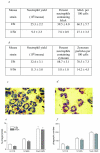Neutrophil responses to Mycobacterium tuberculosis infection in genetically susceptible and resistant mice
- PMID: 15731075
- PMCID: PMC1064912
- DOI: 10.1128/IAI.73.3.1744-1753.2005
Neutrophil responses to Mycobacterium tuberculosis infection in genetically susceptible and resistant mice
Abstract
The role of neutrophils in tuberculosis (TB) resistance and pathology is poorly understood. Neutrophil reactions are meant to target the offending pathogen but may lead to destruction of the host lung tissue, making the defending cells an enemy. Here, we show that mice of the I/St strain which are genetically susceptible to TB show an unusually high and prolonged neutrophil accumulation in their lungs after intratracheal infection. Compared to neutrophils from more resistant A/Sn mice, I/St neutrophils display an increased mobility and tissue influx, prolonged lifespan, low expression of the CD95 (Fas) apoptotic receptor, relative resistance to apoptosis, and an increased phagocytic capacity for mycobacteria. Segregation genetic analysis in (I/St x A/Sn)F2 hybrids indicates that the alleles of I/St origin at the chromosome 3 and 17 quantitative trait loci which are involved in the control of TB severity also determine a high level of neutrophil influx. These features, along with the poor ability of neutrophils to restrict mycobacterial growth compared to that of lung macrophages, indicate that the prevalence of neutrophils in TB inflammation contributes to the development of pathology, rather than protection of the host, and that neutrophils may play the role of a "Trojan horse" for mycobacteria.
Figures






References
-
- Benedek-Spat, E., R. Di Felice, E. Andersen, and G. Cimasoni. 1991. In vitro release of elastase from human blood and gingival crevicular neutrophils. Arch. Oral Biol. 36:507-510. - PubMed
-
- Bliss, S. K., Y. Zhang, and E. Y. Denkers. 1999. Murine neutrophil stimulation by Toxoplasma gondii antigen drives high level production of IFN-gamma-independent IL-12. J. Immunol. 163:2081-2088. - PubMed
Publication types
MeSH terms
Substances
Grants and funding
LinkOut - more resources
Full Text Sources
Molecular Biology Databases
Research Materials
Miscellaneous

